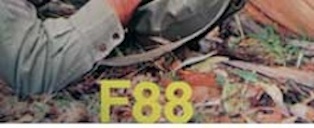
Later in WWII the need for a shorter, lighter rifle for use in the jungles of the Far East led to the development of the Rifle, No. 5 Mk I (the "Jungle Carbine") With a severely cut-down stock, a prominent flash hider, and a receiver machined to remove all unnecessary metal, the No. 5 was both shorter and 2 lb (0.9 kg) lighter. Despite a rubber butt-pad, the .303 round produced too much recoil for the No. 5 to be suitable for general issue. Production of the No. 5 Mk I ceased in 1947 due to an "inherent fault in the design", often said to be a "wandering zero" and accuracy problems. However, the No. 5 Mk I was popular with soldiers owing to its light weight, portability, and shorter overall length than a standard Lee-Enfield rifle.
An Australian experimental version of Jungle Carbine, designated Rifle, No. 6, Mk I was also developed, using an SMLE MK III* as a starting point (as opposed to the No. 4 Mk I used to develop the No. 5 Mk I Jungle Carbine). The No. 6 Mk I never entered full production, and examples today are extremely rare and valuable to collectors. A "Shortened and Lightened" version of the SMLE Mk III* rifle was also trialled by the Australian military, and a very small number were manufactured at SAF Lithgow during the course of WWII.
The term "Jungle Carbine" was popularised in the 1950s by the Santa Fe Arms Corporation, a U.S. importer of surplus rifles, used in the hopes of increasing sales of a rifle that had little U.S. market penetration. It was never an official military designation, but British & Commonwealth troops serving in the Burmese and Pacific theatres during WWII were known to unofficially refer to the No. 5 Mk I as a "Jungle Carbine"[35] to differentiate it from full length SMLE and No. 4 Lee-Enfield rifles.
Both the No. 4 and No. 5 rifles served in Korea (as did the SMLE Mk III*- mostly with Australian troops).
Jungle Carbine was an informal term used for the Rifle No. 5 Mk I, which was a derivative of the British Lee Enfield No. 4 Mk I, designed especially for fighting in the Far East and Burma and other terrain where the length and weight of the standard rifle made it unsuitable. Production began in March 1944, and finished in October 1947.
The No. 5 was about 100 mm shorter and nearly a kilogram lighter than the No. 4 from which it was derived. A number of "lightening cuts" were made to the receiver body and the barrel, the bolt knob drilled out, woodwork cut down to reduce weight and had other new features like a flash suppressor and a rubber buttpad to help absorb the increased recoil. However, as the buttpad had a smaller surface area than the standard Lee-Enfield buttplate, it actually concentrated the force of recoil into a smaller area of the shooter's shoulder.
The term "Jungle Carbine" was colloquial and never officially applied by the British Armed Forces, but the Rifle No. 5 Mk I was supposedly referred to as the "Jungle Carbine" by British and Commonwealth troops during WWII and the Malayan Emergency.
Due to the large conical flash suppressor, the No 5 Mk I could only mount the No. 5 blade bayonet, which was also designed to serve as a combat knife if needed.
One of the complaints leveled against the No. 5 Mk I rifle by soldiers was that it had a "wandering zero"- ie, the rifle could not be "sighted in" and then relied upon to shoot to the same point of impact later on.[1]. Tests conducted during the mid to late 1940s appeared to confirm that the rifle did have some accuracy issues- most likely relating to the lightening cuts made in the receiver, combined with the presence of a flash hider on the end of the barrel.[2]. However, modern collectors and shooters have pointed out that no Jungle Carbine collector/shooter on any of the prominent internet military firearm collecting forums has reported a confirmed "wandering zero" on their No. 5 Mk I rifle[3], leading to speculation that the No. 5 Mk I may have been phased out largely because the British Military didn't want to be issued a bolt-action rifle when most of the other major militaries were switching over to semi-automatic arms[4] such as the M1 Garand, SKS, or FN-FAL. Nonetheless, it has also been pointed out by historians and collectors that the No. 5 Mk I must have had some fault, as the British military continued with manufacture and issue of the Lee-Enfield No. 4 Mk II rifle until 1956, before finally converting to the L1A1 SLR.





